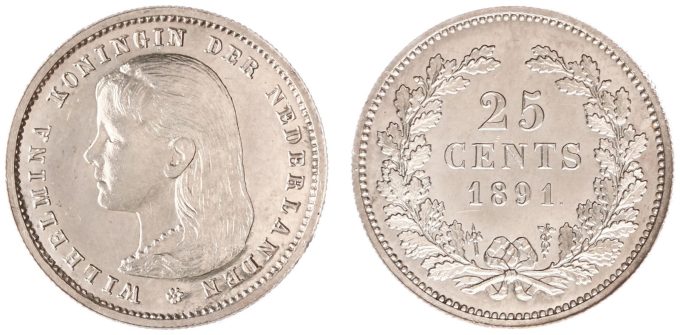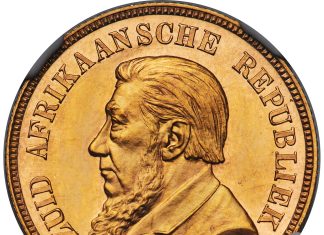Wilhelmina, who was Queen of the Netherlands from 1890-1948, is now royalty of the numismatic realm.

An 1891 Netherlands 25 Cents, or kwartje, sold for €1.045.000 ($1,130,376) at HA-Europe Monday, becoming the most expensive Dutch coin ever sold.
Heritage Auctions Europe-Cooperatief is an affiliate of Heritage Auctions, the world’s leading auctioneer of coins and currency.
The previous record for the most ever paid for a Dutch coin was €700.000 ($757,190) paid in 2021 for an 8-fold gold rosenobel; the best result for a Netherlands Kingdom (1806-present) was the €200.000 paid last year for an 1867 gold double ducat.
"This coin was the cover piece for our catalog, but we expected a hammer price between €300.000 and €400.000," says Jacco Scheper, Managing Director of HA-Europe. "Nobody expected this world record."
Bids came in quickly for the coin, which opened at €300.000 before soaring to its record result in a matter of two minutes.
The 1891 quarter is considered the pinnacle of "Kingdom coins." This record-setting example, which Scheper called "the Holy Grail for coin collectors" in RTL Nieuws, was the only one available on the open collecting market, and has had just four owners in the past century.
This continued a strong week for World and Ancient coins at Heritage, whose CSNS World & Ancient Coins Platinum Session and Signature® Auction brought $11,904,407 as part of Heritage’s Central States Numismatic Society auction events that reached a combined $52,341,143.
About Heritage Auctions
Heritage Auctions is the largest fine art and collectibles auction house founded in the United States, and the world’s largest collectibles auctioneer. Heritage maintains offices in New York, Dallas, Beverly Hills, Chicago, Palm Beach, London, Paris, Amsterdam, Brussels, Hong Kong and Tokyo.
Heritage also enjoys the highest Online traffic and dollar volume of any auction house on earth (source: SimilarWeb and Hiscox Report). The Internet’s most popular auction-house website, HA.com, has more than 1,750,000 registered bidder-members and searchable free archives of more than 6,000,000 past auction records with prices realized, descriptions and enlargeable photos. Reproduction rights routinely granted to media for photo credit.






Not only a likeness, but quite possibly the same die, if not the same coin! However, to me it looks to have been photoshopped. I’ll give the fake coin(circled) a 7 out of 10 for a decent effort to pull a fast one…
Disclaimer–I know nothing about European coinage.
Thank goodness for disclaimers Kaiser! Whew, I knew I needed it! Probably my eyesight. But yet I still cannot find a single emblem near any of the ribbons on the 7 coins that you described as “this Dutch coin” I also see space above all wreaths up to the Dentils?(see how out of touch I am?!)lol.. My circled coin above most resembled the Swiss coin–to a ‘T’ to me, except for the Mint Mark/no Mint Mark difference.. And I agree with your “uncannily reminiscent” descriptor. I guess that’s what allowed me to think that you thought something is amiss–and fake!?… Read more »
I finally get it! Your not talking about the 8 coins that you showed me. Your talking about the ARTICLE COIN !! Sorry for the trouble Kaiser! I see the difference now that I look at the “subject” at hand…Whew!
I better stick with North American coins for now…
Thank you Kaiser. The confusion is all on me for not reading the article first, lesson learned. By the way, that coin is beautiful, so was the Queen. I should’ve known something was amiss when I saw the cross on the large Swiss coin(like my knife). I actually spent an entire month in Europe! I was a teenager along for the ride with my family. It was one of those bus tours(like my daughter does now)and we visited around a dozen Countries. Yes, the Netherlands was one of them LOL! Amsterdam, with the Red Light District was as real as… Read more »
Amazing coin, so old and yet so lustrous. It’s no wonder Kings, Queens, whoever would adorn themselves in the form of Gold jewelry, and on their coins as well.
Considering that this coin holds the distinction that only two were minted and only one is available to collectors, it holds the distinction of being in the league of the 1911 Canadian silver dollar (of which only one is available to collectors) and the 1933 U.S. gold double eagle, among others.